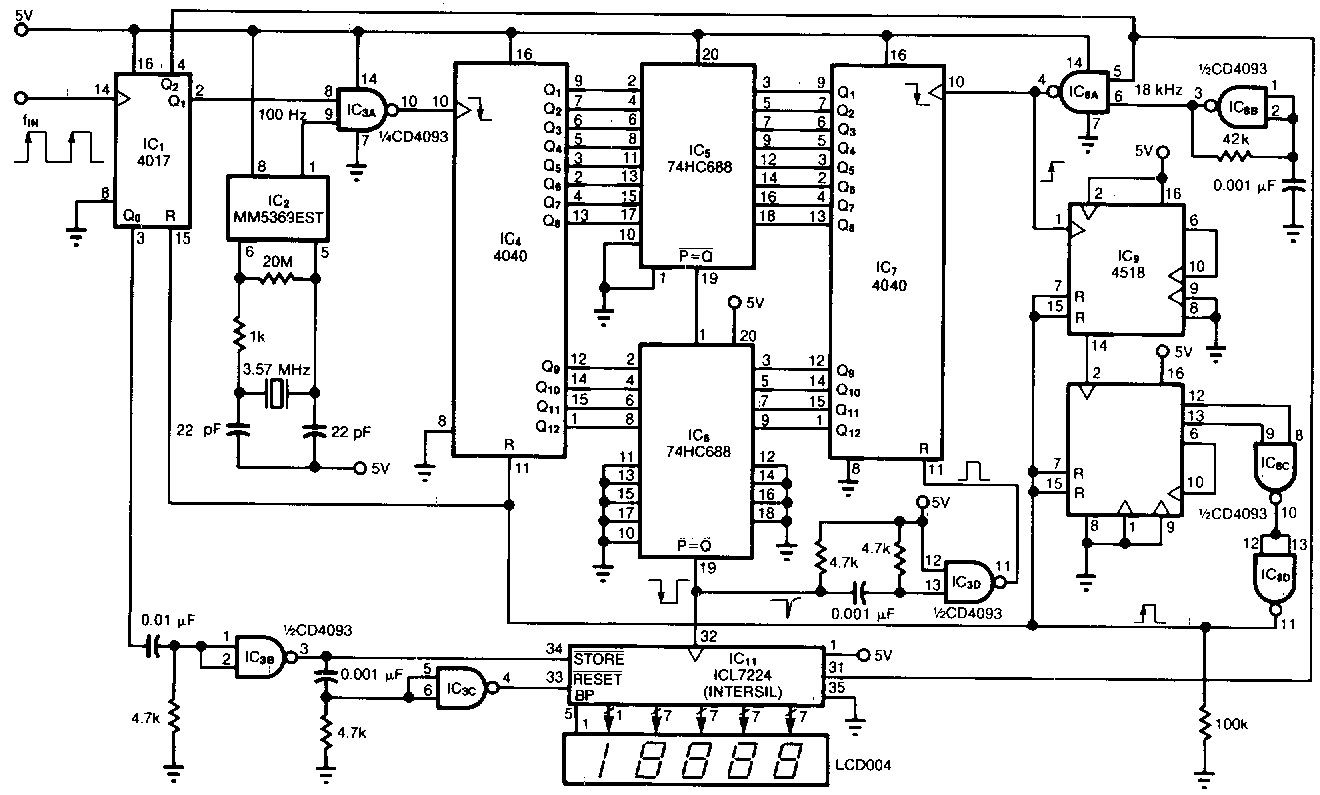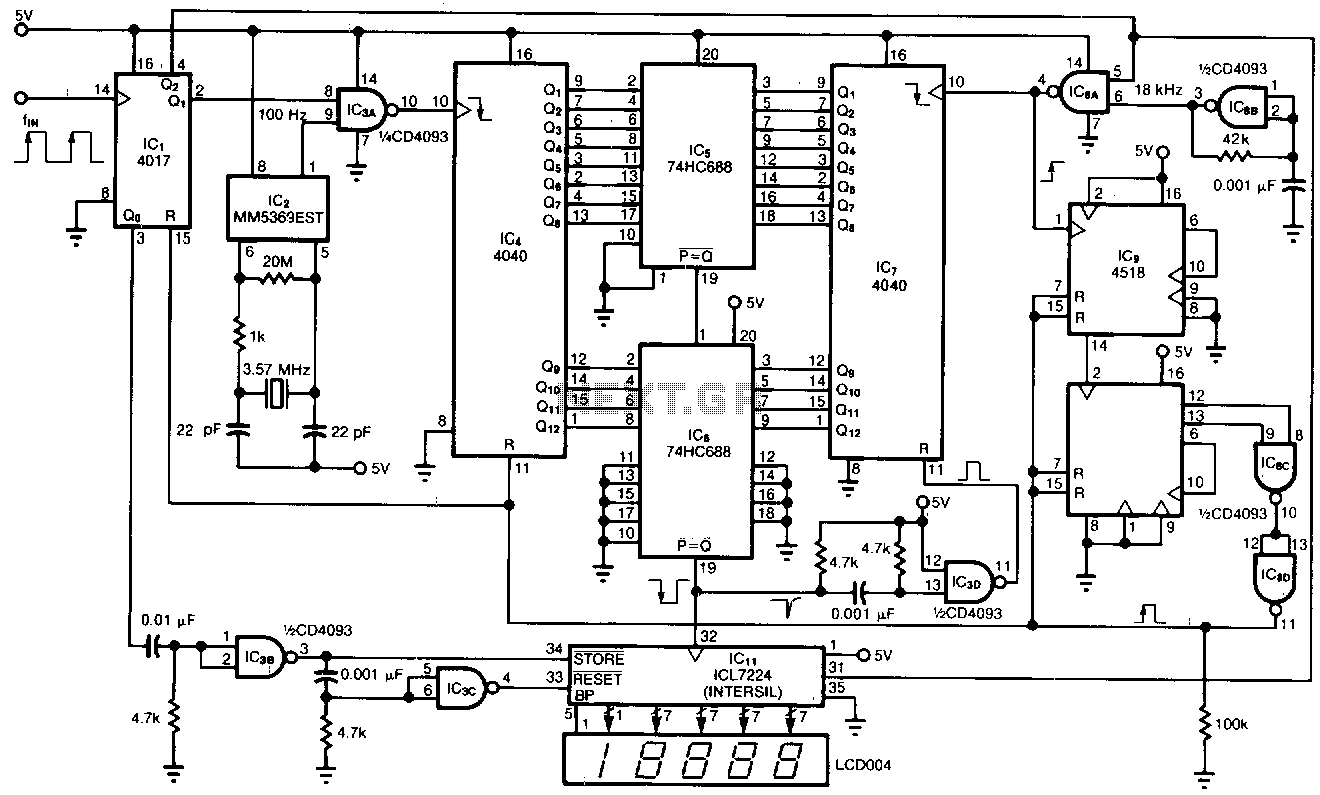
Low-frequency-tachometer

This tachometer measures heartbeats, respiratory rates, and other low-frequency events occurring at intervals ranging from 0.33 to 40.96 seconds. The circuit detects the period of the event, calculates the corresponding pulses per minute, and updates the LCD display accordingly. While the decimal readout indicates 60 times per minute, the circuit does not generate a frequency of 60 times per minute. The computation utilizes counting and comparison techniques and requires 0.33 seconds.
The tachometer circuit is designed to accurately measure low-frequency physiological signals, such as heartbeats and respiratory rates. It operates by detecting the time interval between successive events, which is referred to as the period (fm). The circuit employs a microcontroller or a dedicated timer IC to sample the input signal, which can be derived from various sensors, such as photoplethysmographic sensors for heart rate or piezoelectric sensors for respiratory rates.
The signal is conditioned through a series of analog components, including filters and amplifiers, to ensure that it is clean and within the operating range of the microcontroller. Once the period is detected, the microcontroller calculates the frequency in pulses per minute using the formula:
Frequency (ppm) = 60 / Period (seconds)
This calculation is performed in real time, allowing the LCD display to be updated with the current measurement. The circuit employs a timer interrupt or polling mechanism to ensure that the measurement is taken consistently every 0.33 seconds, providing a responsive and accurate readout.
The LCD is interfaced with the microcontroller using a standard communication protocol, such as I2C or SPI, allowing for easy integration and display of the computed frequency. The design may also include additional features, such as averaging over multiple readings to enhance stability and reduce noise in the output.
In summary, the tachometer circuit is an essential tool for monitoring vital signs, leveraging modern microcontroller technology to provide precise and timely measurements of low-frequency physiological events. Its design incorporates signal conditioning, real-time computation, and user-friendly display capabilities, making it suitable for various applications in medical and fitness monitoring.This tachometer lets you measure heartbeats, respiratory rates, and other low-frequency events that recur at intervals of 0.33 to 40.96 seconds. The circuit senses the period offm, computes the equivalent pulses per minute, and updates the LCD accordingly.
Although the decimal readout equals 60 fm, the circuit doesn`t actually produce a frequency of 60 fm. The computation involves counting and comparison techniques and takes 0. 33 seconds 🔗 External reference
The tachometer circuit is designed to accurately measure low-frequency physiological signals, such as heartbeats and respiratory rates. It operates by detecting the time interval between successive events, which is referred to as the period (fm). The circuit employs a microcontroller or a dedicated timer IC to sample the input signal, which can be derived from various sensors, such as photoplethysmographic sensors for heart rate or piezoelectric sensors for respiratory rates.
The signal is conditioned through a series of analog components, including filters and amplifiers, to ensure that it is clean and within the operating range of the microcontroller. Once the period is detected, the microcontroller calculates the frequency in pulses per minute using the formula:
Frequency (ppm) = 60 / Period (seconds)
This calculation is performed in real time, allowing the LCD display to be updated with the current measurement. The circuit employs a timer interrupt or polling mechanism to ensure that the measurement is taken consistently every 0.33 seconds, providing a responsive and accurate readout.
The LCD is interfaced with the microcontroller using a standard communication protocol, such as I2C or SPI, allowing for easy integration and display of the computed frequency. The design may also include additional features, such as averaging over multiple readings to enhance stability and reduce noise in the output.
In summary, the tachometer circuit is an essential tool for monitoring vital signs, leveraging modern microcontroller technology to provide precise and timely measurements of low-frequency physiological events. Its design incorporates signal conditioning, real-time computation, and user-friendly display capabilities, making it suitable for various applications in medical and fitness monitoring.This tachometer lets you measure heartbeats, respiratory rates, and other low-frequency events that recur at intervals of 0.33 to 40.96 seconds. The circuit senses the period offm, computes the equivalent pulses per minute, and updates the LCD accordingly.
Although the decimal readout equals 60 fm, the circuit doesn`t actually produce a frequency of 60 fm. The computation involves counting and comparison techniques and takes 0. 33 seconds 🔗 External reference
